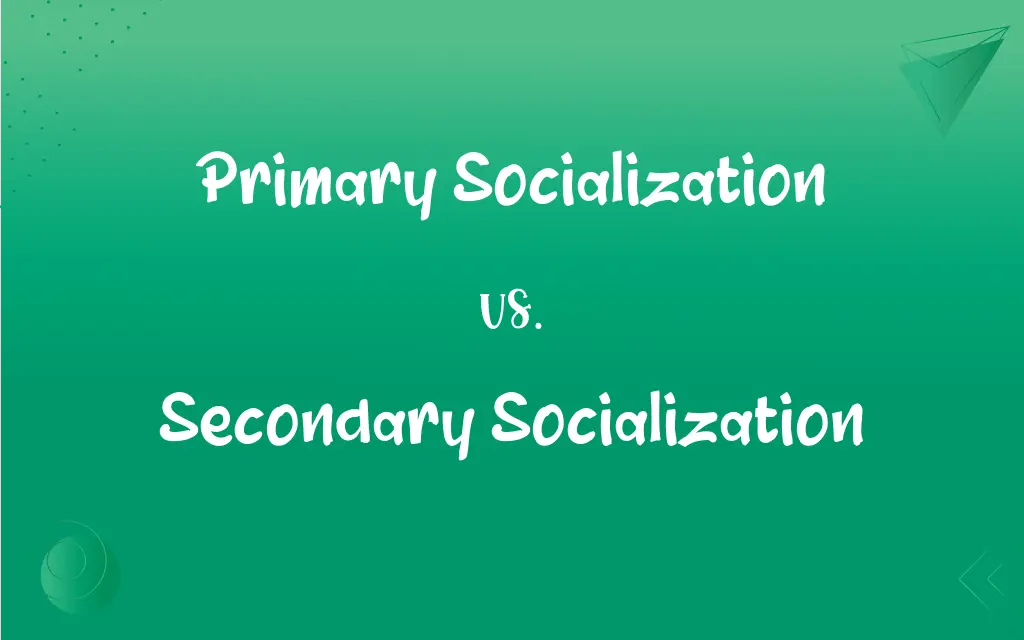Primary Socialization vs. Secondary Socialization: What's the Difference?
By Aimie Carlson & Harlon Moss || Published on September 6, 2024
Primary socialization involves the initial phase where individuals, typically in childhood, learn the norms, values, and behaviors of their society. Secondary socialization refers to the learning that occurs later in life, within specific contexts.

Key Differences
Primary socialization and secondary socialization are foundational processes in the development of individuals within a society, each serving distinct roles in cultural and social integration. Primary socialization occurs in the early years of life, where individuals, usually children, are introduced to societal norms, values, language, and basic behaviors, primarily through their families and close caregivers. This stage is crucial for the development of personal identity and the foundation of one's role in society. In contrast, secondary socialization takes place later in life and continues throughout an individual's lifetime, occurring within specific settings like educational institutions, workplaces, and social groups. This phase involves learning more specialized roles, norms, and behaviors required to function effectively within smaller groups or institutions within the broader society.
The agents of primary socialization are predominantly family members and close caregivers who provide the initial framework of cultural and social norms. This intimate and continuous interaction ensures that the foundational aspects of society's culture, such as language and basic social norms, are deeply ingrained. Secondary socialization, however, involves a broader range of agents, including teachers, peers, colleagues, and media, which introduce and reinforce the norms, values, and behaviors specific to various social environments and roles.
Primary socialization is characterized by its profound impact on an individual's personality, attitudes, and core values. It lays the groundwork for all future learning and social interaction, shaping one's sense of self and basic understanding of societal expectations. Secondary socialization builds upon this foundation, allowing individuals to adapt to new roles and environments, such as transitioning from student to professional or adapting to new cultural settings, thereby expanding one's social identity and competencies.
The content of primary socialization is broad and foundational, focusing on basic societal norms, language, and fundamental values. It is during this period that individuals learn about their cultural heritage, basic moral principles, and the primary roles within their society. Secondary socialization, in contrast, is more specific and context-dependent, tailored to the norms, skills, and behaviors relevant to particular social roles or institutional settings, such as professional ethics in a workplace or the academic standards in an educational institution.
The influence of primary socialization is typically more enduring and pervasive, as it shapes the fundamental aspects of an individual's identity and worldview. Secondary socialization, while also significant, involves more adaptable and changeable aspects of a person's social identity, as individuals may assume multiple roles throughout their lives and engage with various institutions and social groups, each with its own set of expectations and norms.
ADVERTISEMENT
Comparison Chart
Definition
Initial learning of societal norms in childhood.
Continued learning within specific contexts throughout life.
Agents
Family, close caregivers.
Peers, teachers, colleagues, media.
Impact
Shapes personality, core values.
Adapts individuals to new roles, environments.
Content
Broad, foundational norms, and values.
Specific skills, norms related to roles, institutions.
Influence
Enduring, pervasive on identity.
More adaptable, changeable with roles.
ADVERTISEMENT
Primary Socialization and Secondary Socialization Definitions
Primary Socialization
Ingrains basic societal norms and values.
Children learn language and basic manners within the family.
Secondary Socialization
Prepares individuals for specific societal roles.
Schools teach academic and social skills necessary for adult roles.
Primary Socialization
Crucial for developing personal identity.
Early interactions help shape one's sense of self and belonging.
Secondary Socialization
Continues throughout an individual's life.
Learning new social roles and norms with changing life stages.
Primary Socialization
Transfers cultural heritage to new generations.
Family rituals and stories pass down cultural identity.
Secondary Socialization
Introduces norms of various institutions.
Workplaces inculcate professional ethics and organizational culture.
Primary Socialization
Primary agent in imparting cultural norms.
Parents and siblings introduce cultural traditions and moral values.
Secondary Socialization
Peers become significant agents of socialization.
Adolescents often adopt behaviors and attitudes from peer groups.
Primary Socialization
Emotional connections reinforce learning.
Close familial bonds ensure the effective internalization of norms.
Secondary Socialization
Facilitates adaptation to new social environments.
Moving to a new city requires adjusting to its social norms.
FAQs
Why is primary socialization important?
Primary socialization is crucial for integrating individuals into society, instilling basic norms, values, and a sense of identity.
Can primary socialization occur outside the family?
While primarily within the family, primary socialization can also involve close caregivers and early childhood educators.
What roles do peers play in socialization?
Peers significantly influence secondary socialization, shaping attitudes, behaviors, and social skills within peer groups.
How does secondary socialization impact an individual?
It enables individuals to navigate and adapt to new roles and environments, enhancing their social identity and competencies.
Is secondary socialization always formal?
Secondary socialization can be both formal, through institutions like schools and workplaces, and informal, through interactions with peers and media.
What role does media play in socialization?
Media plays a significant role in secondary socialization, influencing perceptions, behaviors, and cultural norms through widespread dissemination of information and ideals.
How does secondary socialization differ from primary?
Secondary socialization focuses on learning within specific contexts and roles beyond the foundational norms taught in primary socialization.
How do cultural differences affect socialization?
Cultural differences can lead to variations in socialization practices, with different norms, values, and roles emphasized in various societies.
What is the role of religion in socialization?
Religion can be a significant factor in both primary and secondary socialization, influencing moral values, traditions, and community roles.
How do educational institutions contribute to socialization?
Educational institutions are key in secondary socialization, imparting not only academic knowledge but also social norms, values, and expectations of societal participation.
Can individuals resist socialization influences?
Individuals can critically assess and sometimes resist socialization influences, especially if they conflict with personal beliefs or are recognized as harmful.
How does socialization contribute to social cohesion?
Socialization fosters social cohesion by promoting shared norms and values, facilitating understanding and cooperation within a society.
Can socialization contribute to social change?
Yes, socialization can contribute to social change as new generations internalize and potentially modify the norms and values they learn.
Can socialization processes change over time?
Yes, socialization processes can evolve with societal changes, technological advancements, and shifts in cultural norms and values.
What impact does globalization have on socialization?
Globalization can broaden socialization influences, introducing diverse cultural norms and values and fostering a more global identity.
How do social norms evolve through socialization?
Social norms can evolve as individuals internalize, reinterpret, and sometimes challenge the norms and values transmitted through socialization.
What challenges can arise in the socialization process?
Challenges in socialization can include cultural conflicts, identity crises, and the internalization of negative or conflicting norms.
What research methods are used to study socialization?
Research methods in studying socialization include surveys, interviews, observational studies, and longitudinal research to understand how socialization processes affect individuals and societies over time.
How does socialization affect individual behavior?
Socialization shapes individual behavior by instilling societal norms and values that guide personal interactions and decisions.
How do life transitions affect socialization?
Life transitions, such as starting a new job or becoming a parent, can trigger new rounds of secondary socialization, adapting individuals to new roles and environments.
About Author
Written by
Aimie CarlsonAimie Carlson, holding a master's degree in English literature, is a fervent English language enthusiast. She lends her writing talents to Difference Wiki, a prominent website that specializes in comparisons, offering readers insightful analyses that both captivate and inform.
Co-written by
Harlon MossHarlon is a seasoned quality moderator and accomplished content writer for Difference Wiki. An alumnus of the prestigious University of California, he earned his degree in Computer Science. Leveraging his academic background, Harlon brings a meticulous and informed perspective to his work, ensuring content accuracy and excellence.






































































